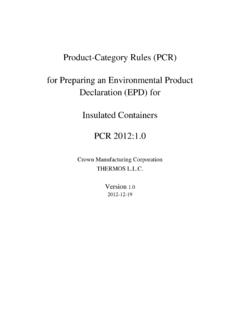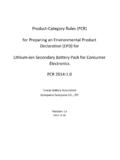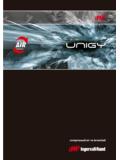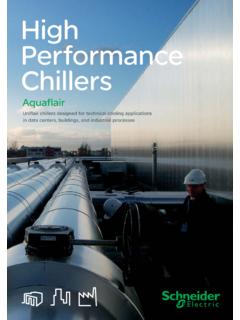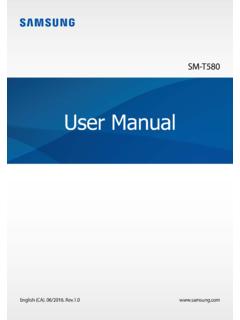Transcription of Product-Category Rules (PCR) for Preparing an ...
1 Product-Category Rules (PCR) for P reparing an environmental product declaration (EPD) for Portable Power Outlets - Extension cords, smart energy Efficiency Devices, Adapter PCR 2011 Michilin Prosperity Co., Ltd. Version 2011-1 2-31 Table of Contents 1. General information 2. Company and product description product group function product components product technical description 3. List of materials and chemical substances 4. Declared unit 5. System boundaries Specifications for different boundary settings 6. Cut-off Rules 7. Allocation Rules 8. Units 9. Calculation Rules and data quality requirements 10. Parameters to be declared in the EPD 11. Recycling information 12. Other environmental information (Optional) 13. Information about the certification 14. References Appendix I Generic data sources to refer to Appendix II Reporting format for the EPD Appendix III Abbreviations 1.
2 General Information This document is to be used as the product category Rules (PCR) for the global production and manufacturing of portable power outlets. The requirements specified in this PCR are intended to be used for EPDs certified in accordance with ISO 14025 standard. This document shall be valid until March 31, 2014. This PCR was prepared by Michilin Prosperity Co., Ltd. Representatives from major Taiwanese manufacturers of similar products and stakeholders were invited by the Taiwan Electrical and Electronic Manufacturers Association (TEEMA) to the open consultation meeting on November 29, 2011, to participate in the discussion and review of this PCR. Environment and Development Foundation (EDF) then reviewed and approved this PCR. This PCR is applicable to products with the Harmonized System (HS) Code of For further information and comments concerning this PCR, please contact: Michilin Prosperity Co.
3 , Ltd. Sandy Yang (tel + fax + email 2. Company and product description The EPD shall include information about the manufacturing company/organization. The information may include manufacturing process related information, and environmental related information, such as the environmental management system information. The information may also include special issues which the company/organization would like to emphasize, such as the products meeting certain environmental criteria, or environmental safety and health related information. This PCR is applicable to both business to consumer/customer (B2C) and business to business (B2B) communications. While conducting certification of product related environmental impacts, the inventory shall also include product accessories and packaging. product group function Portable power outlets include products such as e xtension cords, s mart energy efficiency devices and adapters.)
4 Extension cord: The power cord used to connect an electrical appliance or electronic product with the power outlet, in order to extend the range in which the power-consuming products can be used. smart energy efficiency device: This device has the appearance of a multiple-socket extension cord. But unlike a traditional power outlet which can only extend the range of an electrical appliance or electronic product s power cord, the smart energy efficiency device is capable of saving energy for the connected products, in addition to providing the function of a power outlet. Applications of smart energy efficiency device: automatic monitoring of any electrical appliance standby power consumption, and using intelligent judgment to decide whether to cut off all power supply to unused electrical appliances and achieve zero standby power state. In addition, the device can automatically detect the electrical appliance s power load, issue a warning and cut off the power supply if the appliance s default power load is exceeded.
5 In addition to providing the aforementioned safety functions, the device can also provide protection to noises from power supply and power surge due to lightning. product components The portable power outlet s main components include the following: - Housing; - Outlet metal material; - Current breaker; and - Power cord. For smart energy efficiency device, the main components include the following: - Printed circuit board (PCB); - Microprocessor control unit (MCU); - Surge protect device; - Power control device. Other components: , protective cap for sockets. The data quality requirements for the main components are described in Section 9 on calculation Rules and data quality requirements. The EPD shall also include the other components of the product , but their data quality requirements are different from those of the main components.
6 product technical description The product technical description part of the EPD shall include the following information: - Input voltage; - Output load current; - Panel output socket; - Power surge protection; - Others: specification for remote controller, remote control distance (barrier-free) 3. List of materials and chemical substances The contents of the following materials and substances in the product shall be declared: - All materials of the product (excluding packaging material) with weight ratio (material weight/ product weight (excluding packaging)) 1%; - All materials of the packaging with weight ratio (material weight/packaging weight) 1%; - All materials/substances in the product (including packaging) regulated by legal, customer and environmental requirements; - The following materials in the product components: flame retardants, lead content in solder, lead and flame retardant content in solder masking agent, and substances regulated by EU s RoHS Directive (the latest version).
7 The declaration of halogen-free flame retardants, lead-free solders and no RoHS-regulated substances may only be made when appropriate evidences are available (for example, test reports from accredited laboratories/testing facilities). The following organizations may provide accreditation for testing facilities: Taiwan Accreditation Foundation (TAF), (Asia Pacific Laboratory Accreditation Cooperation (APLAC), International Laboratory Accreditation Cooperation (ILAC) or ILAC Mutual Recognition Arrangement (ILAC MRA). For definitions of testing methodology and confirmations of regulated hazardous substances based on the accredited laboratories product testing methods, please refer to IEC 62321 Standard. 4. Declared unit The declared unit is one unit of portable power outlet.)
8 This unit is chosen because the portable power outlet products are marketed and sold in such a unit. 5. System boundaries The main system boundaries for the declared product system are presented as follows: Figure 1 System boundary of the product system Manufacturing of main components Manufacturing of other components Emission energy energy emission Trpt Trpt Trpt Trpt Trpt Manufacturing phase Use phase energy mandatory inclusion Voluntary inclusion Mandatory inclusion of energy consumption Material production/ extraction Material forming/ refining Products waste disposal Products use Material acquisition phase Emission auxiliary material Assembly of Products Waste/ scrap Trpt Trpt Trpt Trpt energy Waste/ scrap Waste/ scrap Marketing phase Waste Disposal phase Trpt = transportation auxiliary material Marketing of Products auxiliary material As noted in Figure 1 above, the life cycle of a portable power outlet product covers five life cycle stages.
9 Raw material acquisition, product manufacturing, distribution, product use and waste disposal. The data quality requirements for the main components and other components are described in Section 9 on calculation Rules and data quality requirements. Raw Materials Acquisition Stage The LCA shall include information for the following unit processes: - Material extraction and manufacturing of main components and other components; - Production/generation of energy used for raw material manufacturing. The inclusion in the LCA the information on the forming and refining of raw materials and transportation of raw materials is optional (voluntary). Manufacturing Stage The LCA shall include information for the following unit processes: - Manufacturing of main materials and generation of associated process waste - Assembly of products, and associated process waste; - Transportation of main components to product manufacturing site.
10 The inclusion in the LCA the information on the input/output of packaging material during main components manufacturing process and the manufacturing of minor/secondary components/parts is optional (voluntary). Distribution and Marketing Stage The LCA shall include information for the following unit processes: - Transportation of products to the distribution sites or customer designated locations; - The inventory and reporting of energy /resource input and waste generation during the marketing process is optional (voluntary); - The inventory and reporting of transportation from sales/distribution sites to users is optional (voluntary). Use Stage Assumed following scenario for product usage: - Basic models of extension cord and adapter do not use energy by itself. - If an extension cord has a lighted switch, the power consumption of the light bulb shall be calculated as follows: Light bulb s power rating * total number of light bulb(s) * 16 hours/day * 365 days * 7 years (1) - smart energy efficiency devices are designed for prolonged use, therefore they maintain constant power consumption whether in standby or use state.
